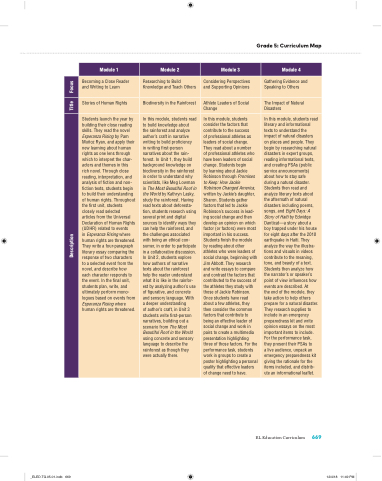Page 693 - EL Grade 5 Teacher Guide
P. 693
Grade 5: Curriculum Map
Module 1
Module 2
Module 3
Module 4
Becoming a Close Reader and Writing to Learn
Researching to Build Knowledge and Teach Others
Considering Perspectives and Supporting Opinions
Gathering Evidence and Speaking to Others
Stories of Human Rights
Biodiversity in the Rainforest
Athlete Leaders of Social Change
The Impact of Natural Disasters
Students launch the year by building their close reading skills. They read the novel Esperanza Rising by Pam Muñoz Ryan, and apply their new learning about human rights as one lens through which to interpret the char- acters and themes in this rich novel. Through close reading, interpretation, and analysis of ction and non- ction texts, students begin to build their understanding of human rights. Throughout the rst unit, students closely read selected
articles from the Universal Declaration of Human Rights (UDHR) related to events
in Esperanza Rising where human rights are threatened. They write a four-paragraph literary essay comparing the response of two characters to a selected event from the novel, and describe how each character responds to the event. In the nal unit, students plan, write, and ultimately perform mono- logues based on events from Esperanza Rising where human rights are threatened.
In this module, students read to build knowledge about
the rainforest and analyze author’s craft in narrative writing to build pro ciency
in writing rst-person narratives about the rain- forest. In Unit 1, they build background knowledge on biodiversity in the rainforest in order to understand why scientists, like Meg Lowman in The Most Beautiful Roof in the World by Kathryn Lasky, study the rainforest. Having read texts about deforesta- tion, students research using several print and digital sources to identify ways they can help the rainforest, and the challenges associated with being an ethical con- sumer, in order to participate in a collaborative discussion. In Unit 2, students explore how authors of narrative texts about the rainforest help the reader understand what it is like in the rainfor- est by analyzing author’s use of gurative, and concrete and sensory language. With a deeper understanding
of author’s craft, in Unit 3 students write rst-person narratives, building out a scenario from The Most Beautiful Roof in the World using concrete and sensory language to describe the rainforest as though they were actually there.
In this module, students consider the factors that contribute to the success
of professional athletes as leaders of social change. They read about a number of professional athletes who have been leaders of social change. Students begin
by learning about Jackie Robinson through Promises to Keep: How Jackie Robinson Changed America, written by Jackie’s daughter, Sharon. Students gather factors that led to Jackie Robinson’s success in lead- ing social change and then develop an opinion on which factor (or factors) were most important in his success. Students nish the module by reading about other athletes who were leaders of social change, beginning with Jim Abbott. They research and write essays to compare and contrast the factors that contributed to the success of the athletes they study with those of Jackie Robinson. Once students have read about a few athletes, they then consider the common factors that contribute to being an effective leader of social change and work in pairs to create a multimedia presentation highlighting three of those factors. For the performance task, students work in groups to create a poster highlighting a personal quality that effective leaders of change need to have.
In this module, students read literary and informational texts to understand the impact of natural disasters on places and people. They begin by researching natural disasters in expert groups, reading informational texts, and creating PSAs (public service announcements) about how to stay safe during a natural disaster. Students then read and analyze literary texts about the aftermath of natural disasters including poems, songs, and Eight Days: A Story of Haiti by Edwidge Danticat—a story about a boy trapped under his house for eight days after the 2010 earthquake in Haiti. They analyze the way the illustra- tions and visuals in videos contribute to the meaning, tone, and beauty of a text. Students then analyze how the narrator’s or speaker’s point of view in uences how events are described. At
the end of the module, they take action to help others prepare for a natural disaster. They research supplies to include in an emergency preparedness kit and write opinion essays on the most important items to include. For the performance task, they present their PSAs to
a live audience, unpack an emergency preparedness kit giving the rationale for the items included, and distrib- ute an informational lea et.
EL Education Curriculum 669
_ELED.TG.05.01.indb 669
12/4/18 11:49 PM
Description Title Focus


